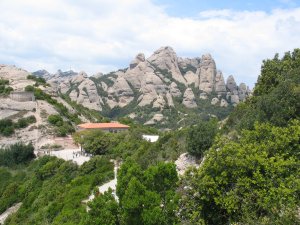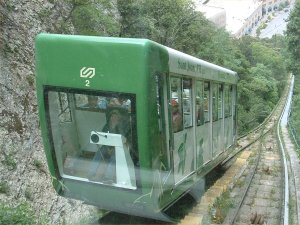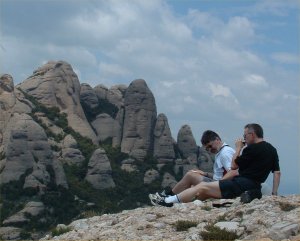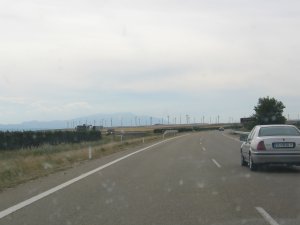Day 13 — Barcelona to Iruña (Pamplona)
The Plan (the whole Plan)
Day 13 : Sun 3 Jun : Through Spain to Jaca
Today, the three remaining members of the party acted pretty much according to type. Patrick did clever things with computers. Mark got enthusiastic about history and politics. And David broke things.
But this all happened later on. First, we headed to Montserrat, a monastery on (as the name suggests) a serrated mountain outside Barcelona. Montserrat is a major tourist destination these days, and not the peaceful contemplative place it presumably once was. But the views are spectacular, and it's a good place to grab a bit of lunch.
| It's quite a long way up. |

|

|
We got to use a rack railway and a funicular to get to the top. |
| You can't really tell from this angle, but the funicular driver was rather fit. (Yes, we know — we're sorry.) |

|

|
The most vertiginous picnic so far. |
The rest of the day was mostly taken up with a long drive through the wide open spaces of northern Spain, where we encountered the first real example of Loloba[1] country of the tour, the monotony broken up from time to time with huge windfarms. Such little excitement as we encountered was provioded by the following:
First, the names of the locations we passed (Barbastro, Huesca) caused Mark to recall his study of 20th Century history. He sang boisterous renditions of Spanish Civil War songs. This did not make the journey pass any more quickly.
Second, a bus caught fire in quite dramatic style, creating a huge hold-up in the middle of nowhere.
Third, when we stopped for fuel, David noticed (a) that the windscreen was covered in squashed insects and (b) that the garage had thoughtfuly provided a bucket and a brush with a long wooden handle. So, armed with (b), he set about energetically cleaning (a). The next thing anyone noticed was a loud crack followed by a splintering sound as the handle broke. Undeterred, David continued his efforts with renewed vigour and the remains of the brush, dislodging various bits of the car and causing them to scatter across the forecourt.
Well, we put the car back together safely enough. And the garage still has a brush, though it isn't long-handled any more.

Finally, we arrived in Iruña. Iruña (sometime spelt Iruñea) is the Basque name for the town more widely known as Pamplona. After some research, Mark argued that we should use the name and spelling in the title of this page: partly by emphasising that the importance of the anarcho-syndicalist tradition in linguistic, cultural and pro-autonomy movements in northern Spain suggested that use of the Basque nomenclature merited support; partly by noting that the spelling with an "e" represented an archaic and purely academic approach whereas the spelling without the "e" reflected current educated and demotic usage; but mostly by waving his arms around a lot.
Anyway, it's the same town that Hemingway wrote about. And we didn't get run over by any bulls. So that's all right.
We explored a little, and found a restaurant that served us a pretty good and very cheap meal (which made up a bit, cost-wise, after the previous night's gourmet effort). And Patrick muttered a lot and swore a bit as we set up yesterday's web page: the array of pictures took a bit of setting up, so we hope you like it.
| Previous day | Index | Next day |